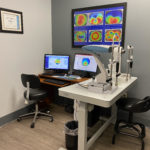
The scleral topographer in Dr. Achong-Coan’s office. She says this instrument improved patient care, increased office efficiency and boosted profitability.
By Roxanne Achong-Coan OD, FAAO, FIAOMC, FSLS
July 27, 2022
Keeping up with patient needs by making targeted changes to your practice can transform care and profitability. Here are a few changes that greatly enhanced the care we deliver and the revenues we generate.
Altogether, I estimate that these three changes added $100,000+ annually in revenues to our practice.
EHR with Greater Customization
We wanted to have a more custom electronic health record (EHR) to increase efficiency throughout the practice. Our new EHR, Crystal Practice Management, has the ability to customize exam templates, so specialty contact lens parameters can be input and set up in patient portals. Patients can input their demographics, health information, and other personal details, which are then directly and automatically imported into our EHR. In turn, the patient can retrieve documents that are uploaded to their portals such as photos, letters, exams, bills and prescriptions. The patient is also able to communicate with the office via this EHR’s patient portal.
Editor’s Note: There are many EHR systems to choose from, including Eyefinity, Compulink and RevolutionEHR, among many others.
We had different EHR companies demo the different parts of their EHR to the different departments in our office to see if every aspect of the technology would meet the needs of our practice and if it was user-friendly. Having each department in our office evaluate the EHR, and provide feedback, before we made our purchase decision ensured we made the right choice. It took around four months to assess and research other EHR systems before making the final decision.
The cost was about $8,000 for purchasing the software, upgrading our servers and adding more computers.
After implementing the new EHR, our profitability increased due to increased efficiency. Patients can be seen in a more timely manner and less time is required from our staff to input patient data, which reduces wait time to see the doctor, and makes check-out speedier.
For example, let us use conservative numbers that we see in our practice. We see an average of 16 patients per day per doctor. In our practice, with three doctors, we save at least five minutes of data input per patient, which is a total of four hours per day of employee time or 20 hours per week. The new EHR also enabled us to notify a patient via text message when their orders are ready to be picked up.
In addition, the EHR enabled us to install a kiosk where patients are able to check-in for their appointments, scan in their IDs and insurance cards and notify our staff that they are picking up their glasses or contact lenses, coming in for an eyewear repair or adjustments, or in our office for another need.
Specialty CL Fitting via Scleral Topographer
Incorporating specialty contact lens fitting into the practice, including the addition of a scleral topographer, made a huge difference to the care we provide patients and our profitability. The cost of this technology was $25,000, via a loan, which was paid off within two months. I reviewed the different brands of scleral topographer available and consulted with other colleagues before purchasing technology from Eaglet Eye.
Editor’s Note: There are other scleral topographers to choose from, including technology from Pentacam and sMap3D, among other options.
This technology enables measurements to take the shape of the sclera, so the sagittal height and scleral and limbal landing zones on the lens can be more customized. Better-fitting lenses result in more comfortable lenses and happier patients who are fully served in fewer visits. Having one less visit not only saves 20-30 minutes in time, but also results in an appointment slot that becomes readily available for another patient. Current and new patients, who were not successful in the past with scleral lenses, have become successful wearers because, not only are they able to have lenses that make their eyes less hyperemic, but they also have better vision than they did in their previous lenses.
Other Articles to Explore
When recommending specialty contact lenses, it is important to understand all modalities and how to fit them so that the right lens is prescribed for the patient. Equipment used, such as an anterior segment OCT, anterior segment photos and topographies, are invaluable when troubleshooting issues. These images can be sent to lab consultants who can assist you in making needed changes.
Our practice’s specialty contact lens services have become a referral source from other eyecare professionals, helping us to grow our practice. The net profit of the average specialty patient is $1,800/patient.
Dry Eye Therapy Services with New Technology
Dry eye is the most common disease we treat. Incorporating dry eye therapy into the practice over the past few years has greatly benefited our patients while helping us to become more profitable.
We started with thermal-based treatment and BlephEx, and then introduced Intense Pulse Light (IPL) treatment, investing in the Lumenis M22, now known as OptiLight.
Editor’s Note: There are other IPL systems to choose from, such as UltraLight from Rohrer Aesthetics, among other options.
The cost of the thermal-based treatment and BlephEx was about $40,000, via a loan, which was paid off in six months. The IPL technology cost approximately $60,000, via a loan, which was paid within a year. The average net profit per patient is about $600 per patient.
In addition to in-office treatments, we sell at-home therapy products, such as Omega 3 supplements, artificial tears and warm-compress masks.
More of our patients with dry eye are now able to wear contact lenses again, and current wearers with dry eye can wear them for a longer period comfortably.
Most of the dry eye treatments we deliver are paid for by the patient out-of-pocket, enabling us to avoid reductions in reimbursements by managed care. We have also experienced an increase in referrals from other healthcare professionals of patients to our practice for dry eye therapy. This change helped patients tremendously and is proving a significant practice-builder.
 Roxanne Achong-Coan OD, FAAO, FIAOMC, FSLS, is a partner with Coan Eye Care & Optical Boutique in Ocoee, Fla. Dr. Achong-Coan has earned the respect of many patients and colleagues across the eyecare industry, helping to make Coan Eye Care one of CooperVision’s Best Practices. To contact her: drcoan@coaneyecare.com
Roxanne Achong-Coan OD, FAAO, FIAOMC, FSLS, is a partner with Coan Eye Care & Optical Boutique in Ocoee, Fla. Dr. Achong-Coan has earned the respect of many patients and colleagues across the eyecare industry, helping to make Coan Eye Care one of CooperVision’s Best Practices. To contact her: drcoan@coaneyecare.com

























